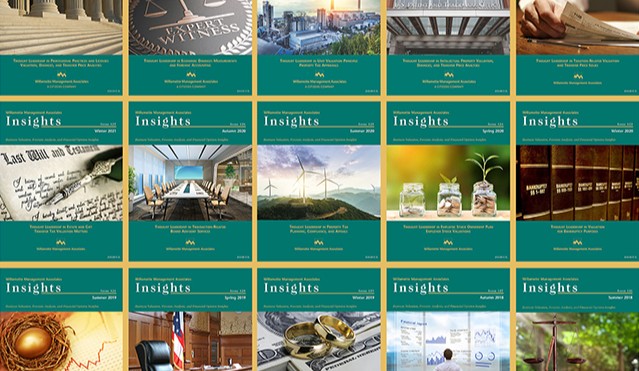
Thought Leadership
Our analysts frequently publish in accounting, finance, and legal professional journals. And our analysts frequently author technical issue white papers for professional organizations. Recent journal articles and white papers authored by Willamette Management Associates analysts are also available here.
Subscribe to Perspectives
Get the latest edition of Perspectives delivered right to your inbox on a quarterly basis.
Perspectives & Announcements
View All
Perspectives
Read More
January 2026 Perspectives
Editors for this issue: Scott R. Miller and Lisa H. Tran
- How Volatile Interest Rates Affect the Cost of Capital and Company Valuations
- Succession Planning in 2026: Employee Stock Ownership Plans and the New Estate Tax Landscape
- The One Big Beautiful Bill Act’s Effect on the Value of S Corporations and Pass-Through Entities

Perspectives
Read More
October 2025 Perspectives
Editor for this issue: Gregory D. Smith
- Business Valuation Implications of the One Big Beautiful Bill Act
- Illiquid for Longer: Private Equity Funds and Financial Opinions
- Was the Jury Reasonably Certain in Huntsman?

Perspectives
Read More
July 2025 Perspectives
Editor for the issue: Jackson L. Crispin
- Tax Court Allows Tax-Affecting for the Discounted Cash Flow Method in Pierce v. Commissioner
- Conflict Transactions and the Evolution of the Fairness Opinion Landscape
- The Application of the Relief from Royalty Method for Intellectual Property Valuation

Perspectives
Read More
April 2025 Perspectives
Editors for the issue: Timothy J. Meinhart and Nathan P. Novak
- Nuances with Respect to Valuing a Controlling Ownership Interest
- Proposed Regulation Changes to Circular 230
- Estate Planning and Buy-Sell Agreements After the Connelly Decision

Perspectives
Read More
January 2025 Perspectives
Editor for the issue: Scott R. Miller
- The Potential Application of Artificial Intelligence in Business Valuation
- Providing Support and Rationale for the Estimation of a Company-Specific Risk Premium
- Comparison of the Business Valuation Development Standards Among Organizations
Perspectives
Read More
October 2024 Perspectives
Editor for this issue: Jesse J. Gillett
- Key Considerations in the Valuation of Carried Interest from a Tax Perspective
- Digging in the Dirt: Performing Forensic Analysis of Financial Records for Valuation Purposes
- Jointly Retained Valuation Engagements: A Road Map for Trust and Cooperation

Press Release
Willamette Management Associates, a Citizens company Announces Promotions
Willamette Management Associates is pleased to announce that six members of our firm have been promoted in 2025.
Read More

Press Release
Willamette Management Associates, a Citizens company Announces Promotions
Willamette Management Associates is pleased to announce that eight members of our firm have been promoted in 2024.
Read More

Press Release
Willamette Management Associates, a Citizens company Hires Brent McDade as Director in Atlanta Office
Willamette Management Associates is pleased to announce that Brent McDade has joined the firm as a Director. He will be based in the Atlanta, Georgia office.
Read More

Insights & Books
Explore more resources from Willamette Management Associates analysts, including Insights, our award-winning thought leadership publication.